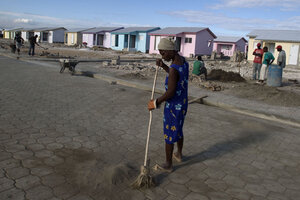Haiti struggles to 'build back better' two years after earthquake
Many of those displaced by Haiti's devastating 2010 earthquake have been relocated, and buildings and roads repaired. But reconstruction in Haiti has been complicated by deep economic and social problems.

A woman sweeps the road near new homes being built for people displaced by the 2010 earthquake in Zoranje, Haiti.
Dieu Nalio Chery/AP
Mexico City
Two years after a devastating earthquake in Haiti - an event some have dubbed the most complex humanitarian crisis of modern times - fresh signs of progress are offering hope.
Two-thirds of displaced Haitians have been moved out of camps. More than half of some 10 million cubic meters of rubble strewn across Port-au-Prince has been cleared. Schools are being repaired and rebuilt. Some 430 kilometers (about 270 miles) of roadway have been constructed or rehabilitated.
But the sense lingers that a comprehensive, long-term plan is sorely missing – even with an investment of $2.38 billion to rebuild from a disaster that killed up to 300,000 people and left 1.5 million people homeless. Many say the “build back better” mantra championed by former President Bill Clinton is nowhere near reflective of today’s reality of an often-chaotic reconstruction process.
“There are some signs of achievement,” says Bernice Robertson, senior analyst for the International Crisis Group in Haiti. “But I think actions are a bit too scattered to give any confidence that ‘build back better’ is happening. People are out of camps, but questions remain: are they in safer, better houses, and safer, better communities? These are the questions that are coming up.”
By far the biggest priority today are those Haitians still living in camps. While approximately 1 million people have been relocated, some 520,000 still live under tents and tarps at 758 camps across the capital.
The UN Refugee Agency (UNHCR) counts an additional 200,000 Haitians who are in equally vulnerable situations, having moved into overcrowded conditions with families or other nonsustainable arrangements, says Charity Tooze, senior communication officer at UNHCR.
The biggest resettlement program is 16/6, which aims to relocate residents of six camps into their 16 original boroughs throughout the city (see related story). But the program, while a positive step, say many, targets only a fraction of those displaced – or about 30,000 people.
Not enough toilets, unemployment high
Many Haitians still lack access to basic services, such as toilets. Seventy percent are underemployed or out of work entirely. And 45 percent of Haitians face food insecurity, according to a new report by Oxfam called “Haiti: The Slow Road to Reconstruction-Two Years after the Earthquake,” which concludes that reconstruction has proceeded at a “snail’s pace.”
The magnitude of the destruction in the overpopulated capital and Haiti’s deeply ingrained social and economic problems have hampered progress. One of the biggest challenges to resettlement, for example, is the dismal state of the land registry, as groups cannot build on land because it is often unclear who owns it. An October 2010 cholera epidemic, blamed on Nepalese peacekeeping forces from the UN, also sidetracked reconstruction.
.
Donors have only dispersed about half of $4.6 billion in funds pledged for Haiti, according to the UN Special Envoy for Haiti, which tracks the funds.
And, perhaps most significant, a political impasse has stalled momentum. Last year’s presidential election led to rioting. And when President Michel Martelly was finally inaugurated in May, his efforts to appoint a prime minister and establish new ministries were thwarted for half a year.
“There was no government in place for five months, a time when there was no direction as to what is supposed to be happening,” says Angela Bruce-Raeburn, Oxfam America's senior policy advisor for humanitarian response in Haiti. “There was a standstill.”
Better outlook for 2012?
With a government in place, many hope that Haiti can turn a corner in 2012. President Martelly acknowledged the need to move forward recently: “We need to help [Haitians] build back better their communities, give them more support, bring them water, infrastructure, electricity, drainage, and police," he was quoted by the Associated Press as saying. "And don't forget to give them the opportunity for them to gain revenue."
Humanitarian groups are pressing for a more expansive resettlement plan, including a clear timetable, so that the displaced can manage their expectations. “We are calling for the president and ministries to create a comprehensive policy that addresses the issues that impact housing in Haiti, issues of land and rentals and forced evictions,” says Ms. Bruce-Raeburn. “Right now that does not exist.”
Aid groups also want a national body to lead efforts, after the mandate of the Interim Haiti Recovery Commission, co-chaired by former President Clinton, expired in October and was not renewed amid the political squabbling.
The current situation leaves many onlookers with the sense that little has been achieved. Alex Dupuy, a sociology professor at Wesleyan University in Connecticut who has written extensively on Haiti, is one of them.
“Other than the humanitarian response, which was quite laudable," he says, "It doesn’t seem to me that a whole lot of progress has been made.”
[ Video is no longer available. ]

